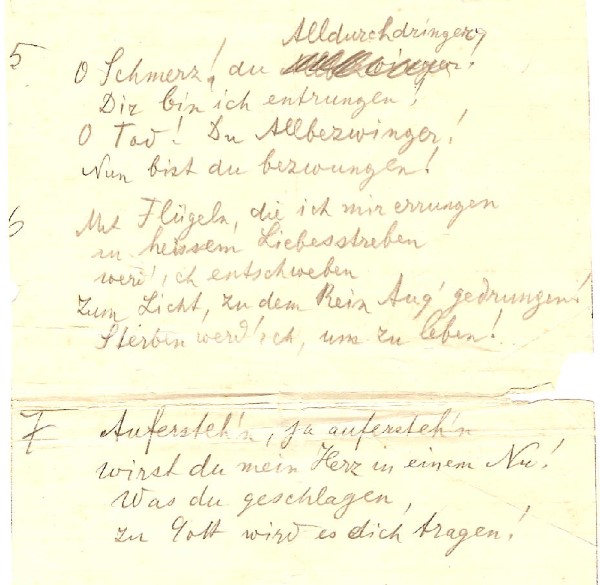At the same speed as the Scherzo. In a wild outburst. The Scherzo’s “cry of despair” is recalled, then answered by a hesitant statement on the horns of the emerging “Resurrection” theme. There follows a “voice calling in the wilderness”, again on the horns, but this time offstage, before the contours are once again blurred by a descending triplet figure that works its way down through the orchestra.
Movement 5: “Aufersteh’n”. Im Tempo des Scherzos. Wild herausfahrend.
Movement 5: “Aufersteh’n”. Im Tempo des Scherzos. Wild herausfahrend.
Movement 5: “Aufersteh’n”. Im Tempo des Scherzos. Wild herausfahrend. Sketch.
The wind chorale then heard against pizzicato quavers (eighth notes) on the strings announces some of the characteristic intervals of the “Resurrection” theme, while at the same time recalling the Dies irae motif heard in the opening movement. But the time for certainty has not yet come. A long orchestral recitative elaborates the theme of human frailty and the anxiety of God’s creatures as the much-feared hour approaches.
A reply comes again in the form of a chorale to which the lower brass add a note of solemnity. The heavens brighten and the return of the brass fanfare prepares for a new statement of the “Resurrection” theme, now far more assertive. This whole series of episodes is linked together in a way that follows dramatic, rather than musical, rules and constitutes a vast prelude, almost 200 bars in length.
Movement 5: “Aufersteh’n”. Im Tempo des Scherzos. Wild herausfahrend. Draft.

Year 1905. Movement 5: “Aufersteh’n”. Im Tempo des Scherzos. Wild herausfahrend written in 1905 by Gustav Mahler for Hendrik (Han Henri) de Booy (1867-1964).
An arresting crescendo on the percussion introduces the Allegro energi-co, a vast symphonic free-for-all based on most of the themes already heard. A return of the “cry of despair” produces a startling effect that is one of the earliest instances of a typically 20th-century “spatialization” effect: offstage brass repeatedly superimpose fanfare motifs on an impassioned recitative that pursues its tireless course, first in the cellos and then in the violins.
The gnawing sense of anguish grows more and more insistent until the brass enter with another triumphant fanfare. Now at last, in an atmosphere of mystery and hope, the radiant “Resurrection” theme appears in its glorious complete form, marking the beginning of the coda in which chorus, soloists and full orchestra come together in a great cry of jubilation.
- 3 Bells low (bass bells or bell plates). In three passages of Movement 5: “Aufersteh’n”. Im Tempo des Scherzos. Wild herausfahrend. Total of 22 bars. Bell foundry Collier.
Text: Friedrich Klopstock (1724-1803) and Gustav Mahler (strophen 1 and 2).
Aufersteh’n
(Chorus and soprano)
Aufersteh’n, ja aufersteh’n wirst du,
Mein Staub, nach kurzer Ruh!
Unsterblich Leben! Unsterblich Leben
Wird, der dich rief, dir geben!
Wieder aufzublüh’n wirst du gesät!
Der Herr der Ernte geht
Und sammelt Garben
Uns ein, die starben!
(Contralto)
O glaube, mein Herz! O glaub:
Es geht dir nichts verloren!
Dein ist, Ja Dein, was du gesehnt,
Dein, was du geliebt, was du gestritten!
(Soprano)
O glaube: Du wardst nicht umsonst geboren!
Hast nicht umsonst gelebt, gelitten!
(Chorus)
Was entstanden ist, das muß vergehen!
Was vergangen ist, auferstehen!
(Chorus and contralto)
Hör auf zu beben!
Bereite dich zu leben!
(Soprano and contralto)
O Schmerz! Du Alldurchdringer!
Dir bin ich entrungen.
O Tod! Du Allbezwinger!
Nun bist du bezwungen!
Mit Flügeln, die ich mir errungen
in heissem Liebestreben
Werd’ ich entschweben!
Zum Licht , zu dem kein Aug’ gedrungen!
(Chorus)
Mit Flügeln, die ich mir errungen
Werd’ ich entschweben!
Sterben werd’ich, um zu leben!
(Chorus, soprano and contralto)
Aufersteh’n, ja aufersteh’n wirst du,
Mein Herz, in einem Nu!
Was du geschlagen,
Zu Gott wird es dich tragen!
Embrace Everything
Listening Guide
If you have found any errors or text needing citation, please notify us by selecting that text and tap on selected text.
Related posts:
- Listening Guide – Movement 4: Finale (Allegro moderato)
- Listening Guide – Movement 1: Langsam (Adagio) – Allegro risoluto, ma non troppo
- Listening Guide – Movement 5: “Aufersteh’n”. Im Tempo des Scherzos. Wild herausfahrend
- Listening Guide – Movement 2: Lied 2: Schlussszene aus Goethe’s Faust
- Manuscript Symphony No. 2
- Listening Guide – Movement 5: Rondo-Finale
